
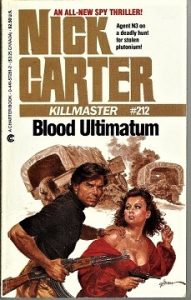 Nick Carter, Master Detective (1943-1955) aired “Murder Goes to College” on December 24, 1944. We have showcased 17 previous Nick Carter episodes since 2009, but this is the first in almost two years. Carter’s history is long, covers numerous media, and is one of the more fascinating we’ve come upon. To crib from one of our earlier entries for new listeners, and slightly tweaked with new material, Nick Carter on radio ran a respectable twelve years, from 1943-1955, but the famous detective’s history begins much earlier. During the post-Civil War era known as Reconstruction, a short story featuring Carter appeared in an obscure fiction paper (The New York Weekly) in 1886 (predating the first Sherlock Holmes story by two years). The publisher was none other than Street & Smith, a fledgling, struggling publishing firm which would later become the most dominant pulp magazine publisher in the world. Among its later titles would be Astounding Science Fiction (now Analog), the only magazine from Street & Smith to survive the pulp magazine crash of the 1950s.
Nick Carter, Master Detective (1943-1955) aired “Murder Goes to College” on December 24, 1944. We have showcased 17 previous Nick Carter episodes since 2009, but this is the first in almost two years. Carter’s history is long, covers numerous media, and is one of the more fascinating we’ve come upon. To crib from one of our earlier entries for new listeners, and slightly tweaked with new material, Nick Carter on radio ran a respectable twelve years, from 1943-1955, but the famous detective’s history begins much earlier. During the post-Civil War era known as Reconstruction, a short story featuring Carter appeared in an obscure fiction paper (The New York Weekly) in 1886 (predating the first Sherlock Holmes story by two years). The publisher was none other than Street & Smith, a fledgling, struggling publishing firm which would later become the most dominant pulp magazine publisher in the world. Among its later titles would be Astounding Science Fiction (now Analog), the only magazine from Street & Smith to survive the pulp magazine crash of the 1950s.
Award-winning radio historian Elizabeth McLeod notes that, “Within a decade, an ongoing series of Nick Carter novels vaulted [Street & Smith] to the front ranks of dime-novel publishers, and made Nick himself a national institution. Nick’s own magazine, The New Nick Carter Weekly, would carry the detective into the twentieth-century.” By 1915, however, the then titled Nick Carter Weekly became Street and Smith’s Detective Story Magazine, a true pulp magazine and S&S’s initial entry into this new format. Again, from Elizabeth McLeod: “Detective Story Weekly soon became Street and Smith’s flagship publication. With the rise of radio in the 1920s, it became the firm’s entree into the broadcast medium. The Street and Smith Detective Story Hour became a favorite of listeners at decade’s end, with elaborate tales of murder and crime hosted by a mysterious narrator introduced only as “The Shadow.” While Nick Carter himself did not appear on the program, his spirit was very much in evidence in the various detective characters that populated the stories.” Of course, we all know what happened next. The mysterious voice only introducing the S&S Detective Story Hour became so popular that S&S launched The Shadow magazine in 1931, and shortly thereafter S&S added Doc Savage to its pulp adventure line. Amidst all of this activity Nick Carter was even given his own magazine (again) in 1933, proving the character’s resiliency and staying power–he was now 47 years old.
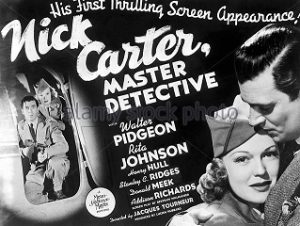
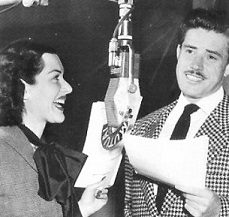 Nick Carter Magazine ran for 40 issues, from March 1933 to June 1936, the final six issues slightly retitled as Nick Carter Detective Magazine. While the magazine had folded, its long-running character still lived, for in 1939 Hollywood picked up the movie rights and produced three “B” Carter films starring noted actor Walter Pidgeon* (who later would star in the classic 1956 SF film Forbidden Planet). A mere three years later, Nick Carter would rise from the dead yet again in his own radio series, Nick Carter, Master Detective. The show’s producer and often the writer, Sherman “Jock” MacGregor, would enlist some of the best writers in the business to script Carter’s episodes, including Robert Arthur and David Kogan of Mysterious Traveler fame, the creator of The Shadow, Walter Gibson, and none other than legendary SF author Alfred Bester (one of which Bester-written episodes, “Chemical Chickens,” we ran in March of 2014 here). Lon Clark played Nick Carter throughout its 12-year run, ably supported by first Helen Choate until mid-1945 (photo above right with Lon Clark) and then Charlotte Manson as Nick’s intelligent, perky secretary Patsy Bowen. Other mainstay characters included Police Sergeant Matty Mathieson, young newspaper reporter Scubby Wilson, and scruffy old veteran of the crime game Waldo McGlynn.
Nick Carter Magazine ran for 40 issues, from March 1933 to June 1936, the final six issues slightly retitled as Nick Carter Detective Magazine. While the magazine had folded, its long-running character still lived, for in 1939 Hollywood picked up the movie rights and produced three “B” Carter films starring noted actor Walter Pidgeon* (who later would star in the classic 1956 SF film Forbidden Planet). A mere three years later, Nick Carter would rise from the dead yet again in his own radio series, Nick Carter, Master Detective. The show’s producer and often the writer, Sherman “Jock” MacGregor, would enlist some of the best writers in the business to script Carter’s episodes, including Robert Arthur and David Kogan of Mysterious Traveler fame, the creator of The Shadow, Walter Gibson, and none other than legendary SF author Alfred Bester (one of which Bester-written episodes, “Chemical Chickens,” we ran in March of 2014 here). Lon Clark played Nick Carter throughout its 12-year run, ably supported by first Helen Choate until mid-1945 (photo above right with Lon Clark) and then Charlotte Manson as Nick’s intelligent, perky secretary Patsy Bowen. Other mainstay characters included Police Sergeant Matty Mathieson, young newspaper reporter Scubby Wilson, and scruffy old veteran of the crime game Waldo McGlynn.
*(The first of the three Nick Carter films was 1939’s Nick Carter, Master Detective. Of interest to genre buffs is that it was directed by Jacques Tourneur, now famous for directing the following trio of Val Lewton horror films: Cat People (1943), I Walked with a Zombie (1943), and The Leopard Man (1943).)
From Nick Carter’s beginnings in 1886 through his final radio show in 1955, Carter would change with the times; from clean-living detective (actually, at the beginning of his career, Nick was a private investigator and consulting detective to the police department, much like Sherlock Holmes, and did not work as a police detective), master of disguise, to anti-espionage agent, to the bane of mad scientists or the defender of scientists beset by crooks, Nick Carter has enjoyed one of the longest surviving, most popular runs in various media for over 100 years, for when his radio show ended in 1955 he would resurface (yet again!) in a series of James Bond-type paperback novels in the 1960s which ran into the 1990s, quite a few of them written by women.
Virtually forgotten today, Nick Carter predates Dashiell Hammett’s Sam Spade, Raymond Chandler’s Philip Marlowe, and was originally inspired by the real-life exploits of private investigator Allan Pinkerton.
With all of the pro-Hamas, anti-Israeli protests marring many of the colleges and universities across the United States this past week, when I ran across the title of this Nick Carter episode it jumped out at me as being rather timely, apropos as it were, even though the strict similarity ends with the title and the location to which it refers, a college. “Murder Goes to College” takes Nick to an elite girls college where a most unlikely student appears to have committed suicide. Rather than involve the police, the college administrators decide to have Nick offer his advice, as any official publicity would reflect negatively on the college. After an initial inspection of the site of the young woman’s death and interviewing several of her classmates, there is just enough doubt as to the cause of death to pique Nick’s interest and begin an investigation in earnest. Was the girl’s death only made to look like a suicide for some unknown reason, and why? Who would have reason enough, not to mention time and resources, to stage the suicide of a young woman in the prime of physical and mental health–someone judged by those who knew her well to have been the least likely to take her own life? As with the real life anti-semitism protests scarring numerous academic landscapes across the United States this week, Nick discovers a larger, more sinister back story and the facts behind the dark reason “Murder Goes to College.”
(The linked CD at top includes this episode and 17 more.)
Play Time: 29:24
{“Murder Goes to College” aired at 3:30 PM on Sunday, Christmas Eve 1944. Knowing that the corner newsstand would close at noon in anticipation of the festivities surrounding Christmas the following day, the neighborhood gang stocked up on some of their favorite detective magazines the day before, when the newsstand would be open that entire Saturday. Crack Detective (1938-57), as we’ve noted before, stood out primarily from the fact that it lived through 8 name changes over its 20-year lifespan, yet managed to keep a faithful readership, so must have been doing something right. It was a bi-monthly in 1944. G-Men Detective (1935-53) began with the title G-Men, but as the love affair with the organization grew commonplace, and media saturation through the movies took its toll, interest in the magazine waned, so around 1940 Detective was added to the title to reflect a new direction for the magazine. It worked, and the magazine ran for another 8 years until time and probably the industry-wide distribution collapse claimed it as another of its legion of victims. It was a quarterly in 1944. Mammoth Detective (1942-47) was one of two mystery-pulp magazines published by Ziff-Davis. Though it had grand hopes for massive issues and a monthly schedule, the war-time paper shortage cut those dreams off at the knees with a much smaller page count and an initial irregular newsstand presence shading gradually to a quarterly schedule. Though it did hit a monthly schedule during 1946 that lasted into 1947 it gave up the ghost with its September 1947 issue. In 1944 it was a quarterly.}
[Left: Crack Detective, 11/44 – Center: G-Men Detective, Fall/44 – Right: Mammoth Detective, 11/44]
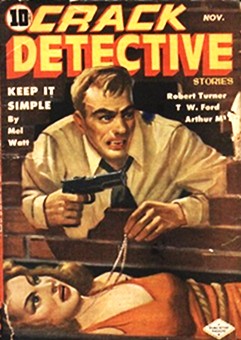
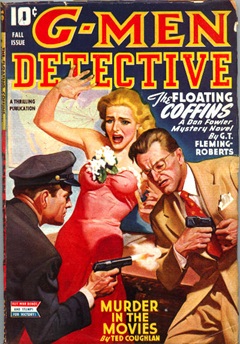
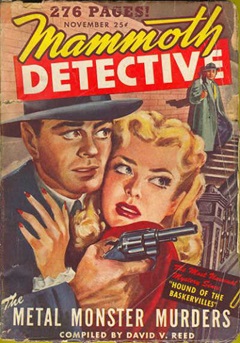
To view the entire list of weekly Old Time Radio episodes at Tangent Online, click here.